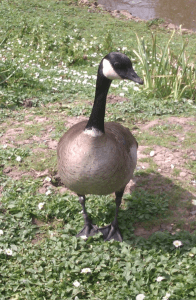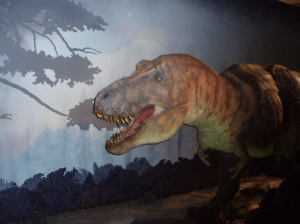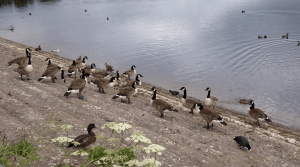One of the finest traditions of all media at Christmas is to shamelessly rip off a classic bit of literature now in the public domain. A palaeontologist studying this phenomenon over time may well describe it as a long-fuse adaptive radiation; diversity and disparity of the text exploding after copyright expiration. Seeing as it is the holiday season, I thought we’d have a bit of fun with this ourselves whilst still learning about palaeontology. And so, without further ado, I present to you, the BDP Christmas Carol… And no, I can’t believe we’re doing this either.

Our story will spin the old classic by being told from a perspective never before explored, that of a bird in the Victorian age. Well, I guess Disney did exactly this, but we aren’t going to anthropomorphise as much… And we’ll make ours a goose rather than a duck to really stamp the difference down. A Royal Canadian Goose. Yep, an R. C. Goose… A name that isn’t an anagram of anything relating to this story.
Our goose was arrogant; a noble bird who considered himself the absolute pinnacle of evolution. He was proud of his ability to fly at a maximum speed of nearly 60mph, his almost 2m wingspan, and the layers of sleek waterproof contour feathers over his insulating down. As the goose settled down for sleep on the 24th December, he could feel confident that there had never been a more impressive hollow-boned, bipedal, vertebrate than him. That pigeon down the road was chatting out his cloaca, and don’t even get started on the ratites. They can’t even fly.
But then, as his goose eyes began to close, there was a flash of light as a deep low rumble forewarned the arrival of a gigantic beast before him. The goose honked loudly in alarm; for he was a goose and lacked the necessary grasp of the English language to convey his feelings precisely.
Standing there was an angelic figure, covered in feathers, 5 meters tall, with powerful hind limbs, a long tail, and bizarrely small arms. Its head was five-foot-long with a narrowing snout allowing for binocular vision and better depth perception; clearly this animal was a predator. The mouth was filled with incredibly sharp teeth, each one the size of a banana and serrated at the edge for cutting through meat. The goose shuddered at the sight of them, if it indeed could see them… There may or may not have been a lip covering the teeth when the mouth was closed… The goose didn’t feel confident enough about this observation to say for sure one way or the other and risk the irk of the scientific community.
This animal was a dinosaur, a ghost of birds past, Tyrannosaurus rex. Though the goose did not yet know this name, as the species would not be discovered and named until 1910. But also, and perhaps more importantly because, as I’ve mentioned before, he was literally just a goose and unable to comprehend what exactly was happening. Instead he continued to honk incessantly, increasingly alarmed at his apparent predicament.

![]() Although, if this was supposed to be a distant ancestor of the birds, it looked a little bit off. The arms were all wrong. Bird arms are famously quite big, making wings so large they had to be folded back against the body using special carpal bones of a semi-lunate shape. This Tyrannosaurus had extremely small arms. There was no way that this animal or its descendants would be taking to the skies anytime soon. These looked more like the vestigial arms of a distant cousin rather than a direct descendent. Surely there were some relatives a bit more similar to our goose, maybe animals evolving along a parallel line… A para-ave if you will?
Although, if this was supposed to be a distant ancestor of the birds, it looked a little bit off. The arms were all wrong. Bird arms are famously quite big, making wings so large they had to be folded back against the body using special carpal bones of a semi-lunate shape. This Tyrannosaurus had extremely small arms. There was no way that this animal or its descendants would be taking to the skies anytime soon. These looked more like the vestigial arms of a distant cousin rather than a direct descendent. Surely there were some relatives a bit more similar to our goose, maybe animals evolving along a parallel line… A para-ave if you will?
With that there was another flash of light. Now, instead of the giant Tyrannosaur there stood a much smaller creature. Similarly to the T. rex this newcomer had a bony jaw with sharp teeth, and a long bony tail. It was certainly another predatory dinosaur, but much smaller, only about 30 cm off the ground. It was the kind of animal that might have looked good in a blockbuster film directed by Steven Spielberg, but in miniature. A fitting name would have been something like Microraptor.
The arms of the Microraptor were much longer relative to the body than most, with those long filamentous feathers and arms folded back. These were true wings. Still though, they looked a little bit primitive, with small claws protruding from the wrists, perfect for climbing trees. The goose thought for a moment of its distant relative in South America, Hoatzin. He was a bit of an oddball, but him and goose had bonded over a mutual love of eating grass.
But this Microraptor was much more bizarre than even the Hoatzin, or any bird alive today. It appeared, not only to have wings on its forearms, but long feathers extending from the rear legs as well. This dinosaur had four wings. It was as if it were trying to be a bird but got some very basic facts wrong and overcompensated for this in a ludicrous manner.
Even in its ghostly form the dark feathers of the Microraptor gleaned with iridescence. It was almost as if the alignment of pigment structures in the dinosaur’s feathers created a physical feature capable to splitting light into its multicoloured spectrum like a prism in a commonly performed GCSE science experiment.
“Honk” cried the goose. It was clear from the sound and pitch of the honk that the goose was having a metaphysical crisis, thinking about his own place in the universe. Sadly, he thought of his own neck of plain black feathers and realised that perhaps he wasn’t as advanced and derived as he previously assumed; that there had been many species before him in his family tree, some truly awe inspiring.
Either that or the goose was still vocalising its distress from the unprecedented situation. Having a shape-shifting ghostly apparition of a dinosaur in front of you is an alarming development in any goose’s day, and one he could frankly have done without. He’d flown south from Scandinavia recently precisely to avoid this kind of thing.
Thankfully he didn’t have long to ponder for, as suddenly as it had appeared, the creature disappeared once more. The ghost of birds past was gone, and the goose tried to return to slumber. But the night was not over yet.
Again a flash of light startled him awake and, sitting before him now was another goose, identical to him in every way. The ghostly bird sat there for a moment, staring in silence at our goose while he stared back. Being partial to a bit of flocking together, our hero thought absolutely nothing of this and settled back to sleep quite contently. The ghost of goose present may well have had an important message for our goose, but if there was one nobody would ever know, as he slept right through it.
When he awoke a bit later, the duplicate goose was gone. It almost felt as though there had been no purpose to that second visitation at all; as if this story was conceived with only two sections fleshed out but the structure of the classic tale demanded three distinct ghostly apparitions.

Even the goose, with a very limited ability to understand anything going on around it, could recognise this as laziness on the writer’s part. He sat there and wondered further why there hadn’t been a Bob Cratchit, Tiny Tim, or Jacob Marley either. A shame really, as there were probably bird puns that could have been made for their names. The story could have written itself. Thoughtfully the goose waited for the next flash of light he assumed would come before his suddenly out of character prescience got the author of this parody in even more trouble.
The flash came, but it did not bring what the goose may have expected. There was no individual creature before him but instead dozens of ghosts. These were the ghosts of birds future, and they made for a sad sight.
The goose recognised many of his friends faces in the crowd; the Passenger Pigeon, Great Auk, and Carolina Parakeet were amongst them. These ghosts were exactly that, ghosts. In the years between our goose settling down for sleep on this Christmas eve and his story first being told, over 100 species of bird have been declared extinct due to human activity. Some were victims of habitat loss, others of massive hunting pressures, and now due to climate change. The goose cast his gaze out over the landscape, or as much as it as he could see through the thick fog of the Victorian industry. He feared that this change had already begun.
A single tear rolled down the goose’s cheek in sadness and pure shock at the dark turn this formerly light-hearted and comical story had suddenly taken. So distracted was he by it that he didn’t even question the fact that as a goose he didn’t have tear ducts able to form tears in the same way as primates.
Following the visits from those ghosts of scientific understanding, the goose felt a renewed respect for life. Perhaps he wasn’t the pinnacle of evolution, but instead just one small branch in an infinitely complex tree of life, with many incredible animals having come before him and, with luck, many more forms to come in the millions of years after him. It was humbling and inspiring, filling the goose with new found respect for the animals he shared the world with, each with the same fascinating stories before them waiting to be discovered.
Unfortunately, it seemed the goose wasn’t able to put his new life view into practise. One of the local old primates down the way must have woken up in an absolutely foul mood after some visitations of his own, as his first act of Christmas day was to throw money at a small boy on the street and demand the execution of the finest goose in the land. Funny old world isn’t it?

